Gallery Grounds and Buildings

1. The Maruki Gallery for the Hiroshima Panels / 2. Kannon Temple / 3. Hakkai Hall / 4. Gravesite / 5. Memorial Stone / 6. Nogi Pavilion / 7. Ruru Rest Area / 8. Private Residence (Archival vaults on the second floor) / 9. Toki River

1. The Maruki Gallery for the Hiroshima Panels
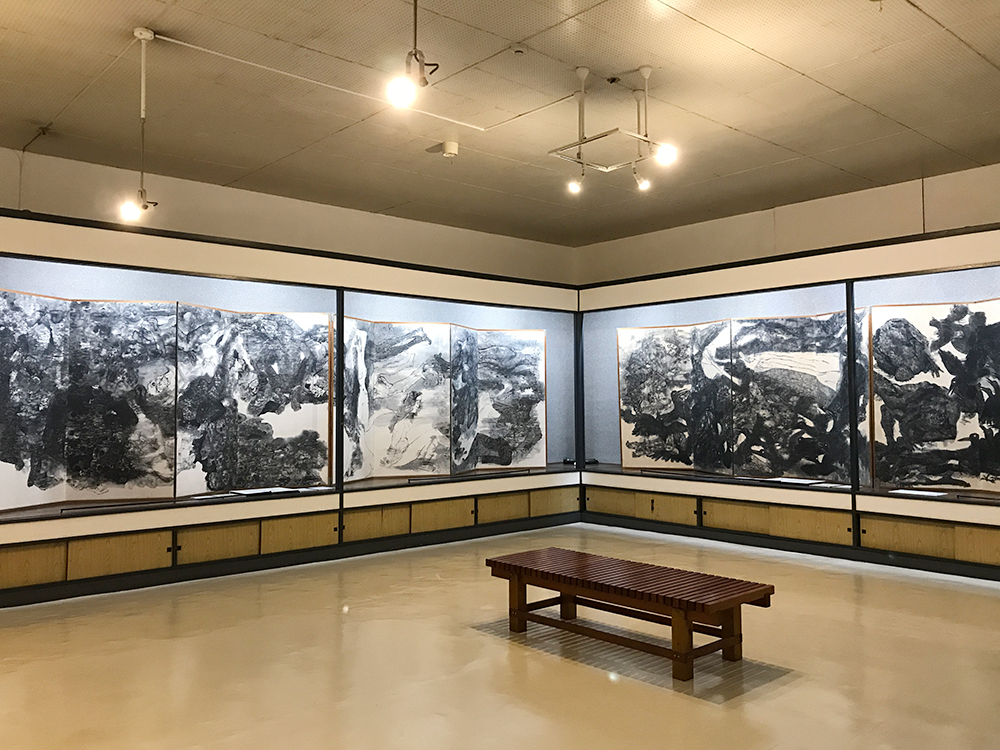
First Floor Exhibit Area
“The Hiroshima Panels (IX)-(XIV)” are on permanent display. One panel depicts “Daigo Fukuryu Maru” (Lucky Dragon #5), wooden tuna fishing boat, exposed to radiation after the US army conducted nuclear testing at the Bikini Atoll in the Pacific Ocean. Another shows the petition movement created to ban atomic and hydrogen bombs. Another focuses on the American prisoners of war and the Korean people exposed to the atomic bombs. These panels show how Japanese society has evolved in facing issues relating to the atomic bombs and World War II.
In the new wing of the gallery, four large scale wall panels which are also collaborative works of art by the Marukis are on display, facing each other on each of the four walls of the room. They are titled “Auschwitz”, “The Rape of Nanking”, “Minamata”, “Minamata, Nuclear Power, Sanrizuka”.
Each year, the Special Exhibition Hall hosts four to five special exhibits. Some exhibits display works by artists of various ages who focus on the current state of war or other social issues. Iri Maruki, Toshi Maruki, and Suma Maruki’s works are sometimes exhibited here as well.
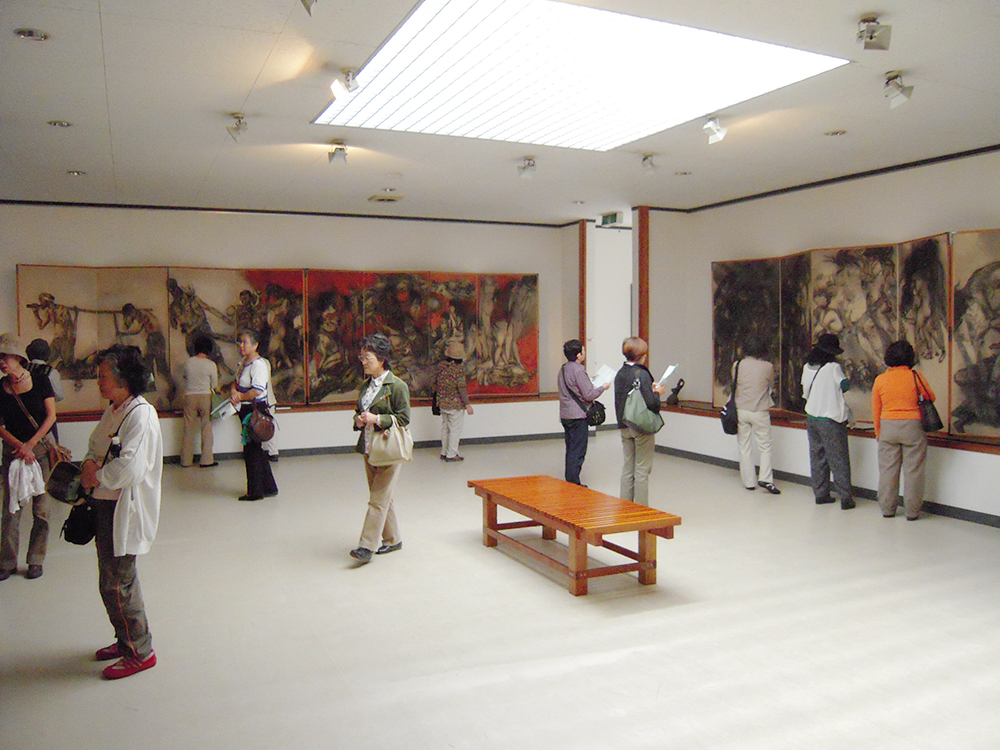
Second Floor Exhibit Area
“The Hiroshima Panels” (I)-(VIII), which are collaborative works of art by Iri and Toshi Maruki are on permanent display. These murals depict the atrocities that Hiroshima faced after the atomic bombing, and are a timeless reminder to all who view them of the pain and suffering of the victims.
The smaller exhibit space is used to display rotating works of art including the works of Suma Maruki, Iri Maruki’s mother, who began painting in her seventies. Suma depicted living things, flowers, and vegetables, and her artwork is known for its colorful and carefree style.
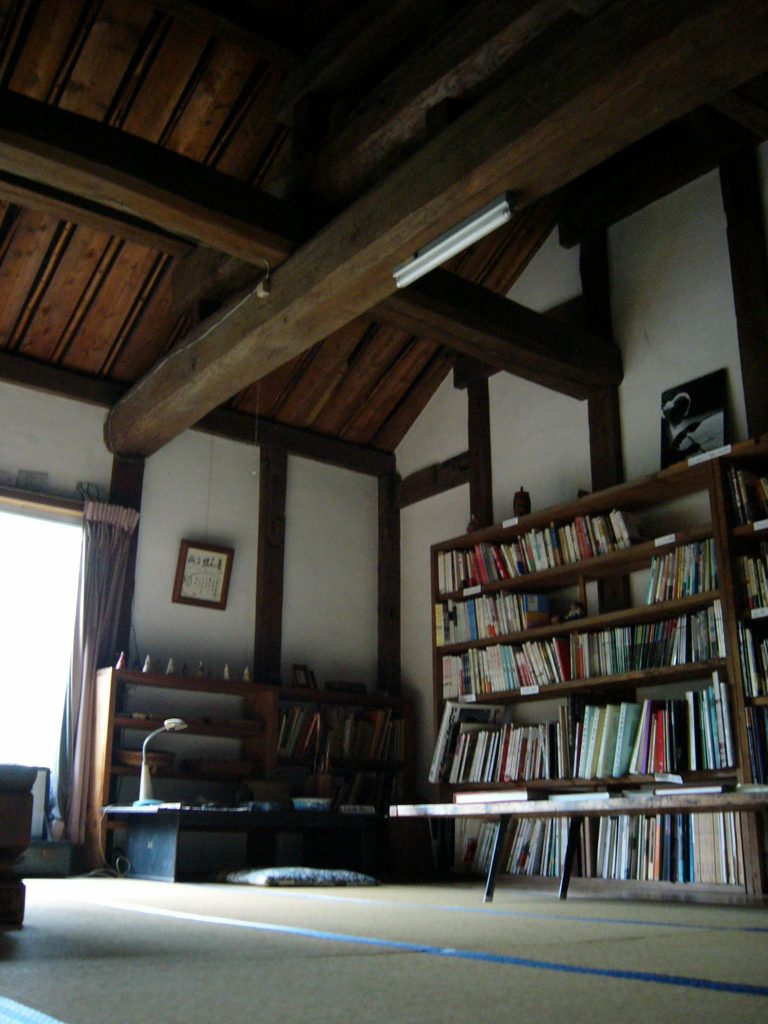
Odaka Library
During the Edo period (1600-1868), this building was the headquarters of the Odaka Clan, the samurai family hereditarily responsible for the governance of the Musashi Matsuyama region (now Higashi-matsuyama City, Saitama Prefecture), and it housed their archives. In the 1970s, a group of the Marukis’ supporters gave them the property, as a testament to their friendship.
The Marukis used the Japanese-style room for many years as a reading room and much-loved atelier. The thick, wooden crossbeams lend the room an antiquarian feel, and the views over the river of the fecund hills and changing seasons have made the room a favorite amongst today’s museum visitors. Feel free to take some time to rest and relax here.
In one corner of the room you will find a low desk set with many of Toshi and Iri’s favored objects, and the library is stocked with reading materials by and about the Marukis, as well as catalogs of their artwork, which you are welcome to peruse.
2. Kannon Temple
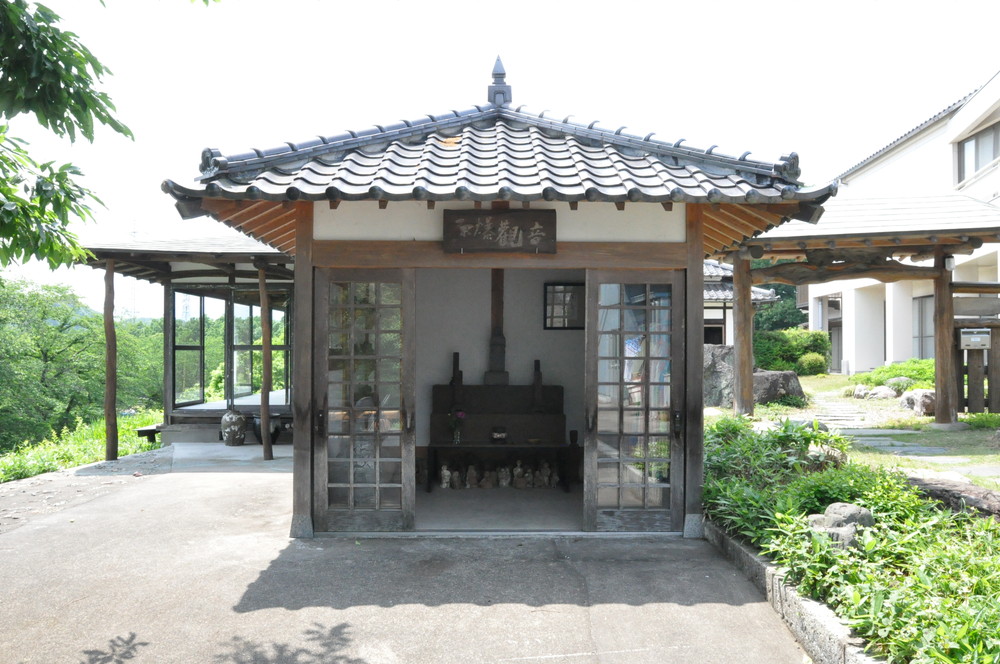
In the front garden of the Maruki Gallery you will find a small temple. It is built from a portion of Iri’s family homestead in Mitaki Town, located just 2.6 kilometers from the hypocenter at Hiroshima. The atomic blast knocked the house sideways and blew off most of the roof.
Though many of his family members died in the bombing, part of the home survived and, in 1970, Iri arranged for this section to be transported to the Gallery and consecrated as a memorial temple. A statue of Kannon, the Buddhist Goddess of Mercy, is enshrined inside the temple. This statue was salvaged from a temple that had been destroyed in the blast.
Each year, many people bring carefully folded paper cranes, in memory of the dead and in the hope for peace. [For more on this tradition, see the children’s story Sadako and the Thousand Paper Cranes, by Eleanor Coerr.]
Though it is fading with time and becoming quite difficult to make out, just beneath the roof of the temple there is a decorative inscription of the poem “Hiroshima Panels” by the poet, activist, and atomic bomb survivor Toge Sankichi (1917-1953)
3. Hakkai Hall

The Hakkai Hall is located just opposite the entrance to the Gallery. It was constructed to mark the 15th anniversary of the Gallery’s opening and was unveiled on May 5th, 1982.
The hall features a calligraphic inscription by Iri reading “The Eccentrics of Gei Shu” (芸州八怪), a reference to the so-called Eight Eccentrics of Yangzhou, a group of 18th century Chinese painters who rejected orthodox ideas about art in favor of a highly individual, expressive style. Iri must have felt that this closely matched his own sensibility, and he had gone to see some of their work during a tour of China the previous year.
“Gei Shu” is an older place name for what Is now western Hiroshima, so Iri made use of the near homophony of the place names in this inscription celebrating the Gallery. The wooden table and seats in the hall come from the same tree whose wood Iri used for the calligraphic decoration.
Visitors to the museum use the hall today as a rest spot, and it is also employed during Gallery events as a stage and open-air lecture area.
4. Gravesite
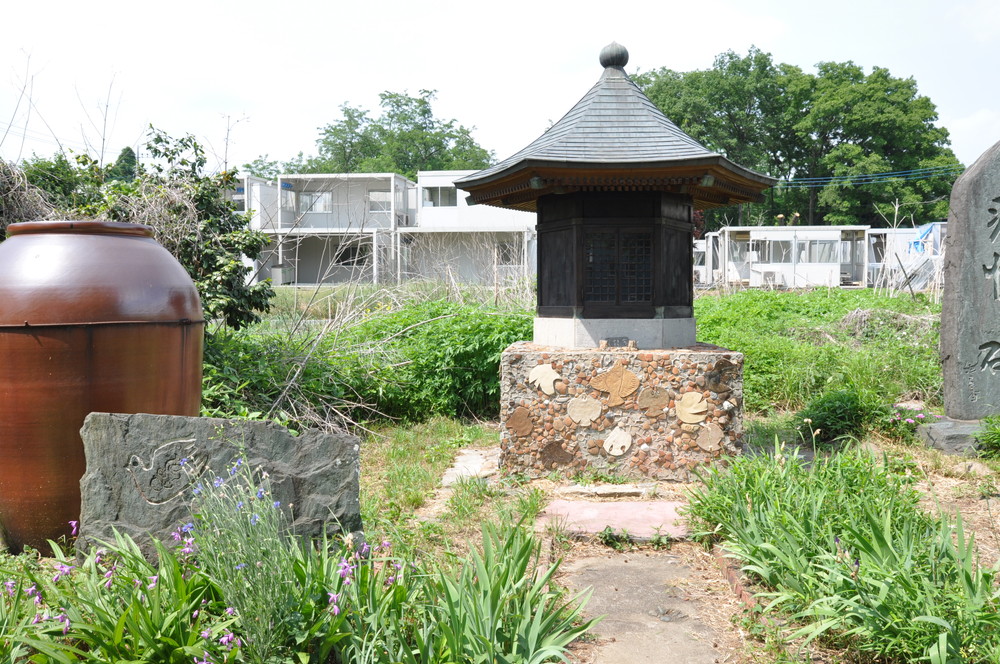
At the far side of the Gallery parking lot there is a small building called the Sosendo (literally “temple for Song Dynasty coins”). In December of 1972, when repairs to the Gallery’s waterlines were being carried out, approximately 50,000 Chinese coins dating to the Song dynasty (960-1279) were unearthed and the Sosendo was constructed in 1979 to commemorate this find.
Just in front and to the left of the building is a black stone, on which one of Suma’s sayings is engraved in Iri’s hand. It reads, “If people do not drop the Bomb, it will not fall” (Pika wa hito ga otosanya, ochitekon).
5. Memorial Stone
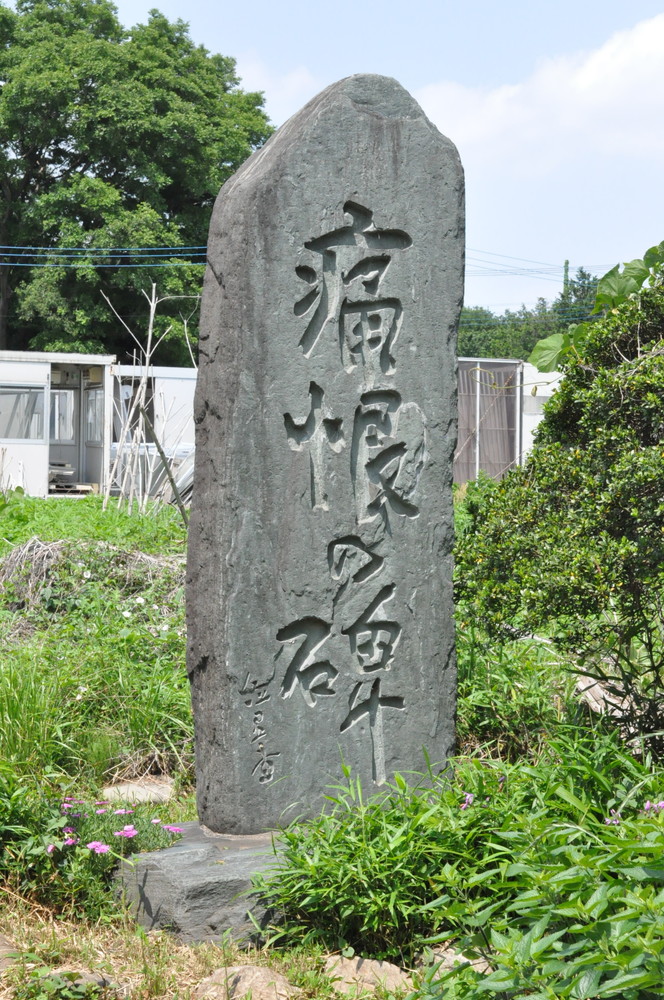
The upright memorial stone standing near the Sosendo commemorates the 1923 Great Kanto Earthquake and, more specifically, the Koreans who fled to Saitama from Tokyo, but who were murdered there because of spurious rumors blaming them for, among other things, the many fires that broke out across the region in the wake of the quake. The memorial stone was erected in 1986.
This was around the same time that the Marukis were making regular trips to Okinawa to gather information about the Battle of Okinawa. While in Okinawa, they came across a memorial stone upon which had been engraved the names of Kume islanders and Koreans who had been killed by the Japanese military. The memorial stone on the Gallery’s grounds was inspired by the similar marker in Okinawa. The carving is based on Iri’s calligraphy.
6. Nogi Pavilion
This traditional Japanese house, originally with a thatched roof, was relocated from Nogi, Tochigi Prefecture in 1970. The Marukis used this house to entertain visitors.
7. Ruru Rest Area
This tea-ceremony room was relocated from Tokyo in 1977. In the latter years, the Marukis used this room as their atelier, as the room is flooded with sunlight during the day.
8. Private Residence (Archival vaults on the second floor)
The Marukis’ residence (not open to public). The second floor is now used as storage space for their works of art.
9. Toki River

This river can be seen from the windows of the gallery. The Marukis chose to move to this area because the Toki River reminded them of the Ota River in Iri Maruki’s hometown of Hiroshima. Every year on August 6th, the anniversary of the bombing of Hiroshima, a lantern ceremony is held to honor the lives lost.
